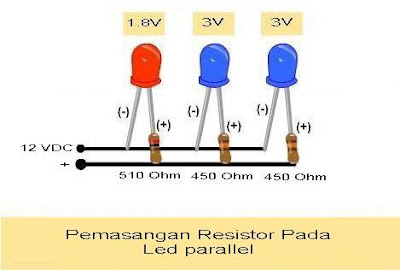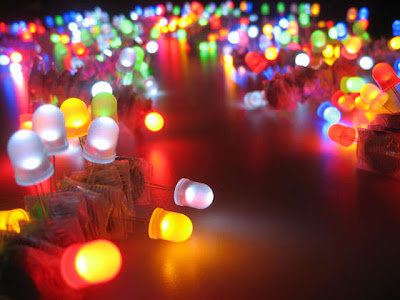How to choose a resistor to turn on the LED? Why LEDs need resistors? That's because the LED does not have a current regulator, the LED will burn out if no resistor.
The amount of flow determines how bright an LED. Greater flow of the lighter flame of an LED. Current in the LED should be approximately 10-20 mA. When a current passes through a LED, the LED voltage drop of about 1.85 V or depending on the type of LED that is in use
The amount of flow determines how bright an LED. Greater flow of the lighter flame of an LED. Current in the LED should be approximately 10-20 mA. When a current passes through a LED, the LED voltage drop of about 1.85 V or depending on the type of LED that is in use

To determine the resistor on the led first consider the graph above (right graph ). Choose the desired LED light and use this chart to determine the required flow. For example, if the desired luminous intensity (high / dark light an LED) for 1, can be seen that the currents are in need of 20 mA.
This shall mean the current 20 mA to pass through the LED, to get the brightness of LED = 1. Now, we can calculate the voltage drop across the LED based on a known flow. Look at the graph on the left at 20 mA. Now you know that the fall in voltage of 1.85 V. Know that the voltage drop across the LED is not only a function of current, but also the color of the LED and the temperature (because of chemical differences in the LED).
Color Potential Difference (LED voltage)
- Infrared : 1.6 V
- Red : 1.8 V - 2.1 V
- Orange : 2.2 V
- Yellow : 2.4 V
- Green : 2.6 V
- Blue : 3.0 V - 3.5 V
- White : 3.0 V - 3.5 V
- Ultraviolet : 3.5 V

Resistor values = (voltage source - LED voltage) / LED current
- Red LED resistor values (12 V- 1.8V) /0.02 A = 510 ohms
- Blue LED resistor values (12V - 3V) / 0.02 A = 450 ohms
 Resistor values = (voltage source - the total LED voltage) / LED current
Resistor values = (voltage source - the total LED voltage) / LED current- Resistor values = (12V - 9.6 V) / 0.02 A = 120 ohms








